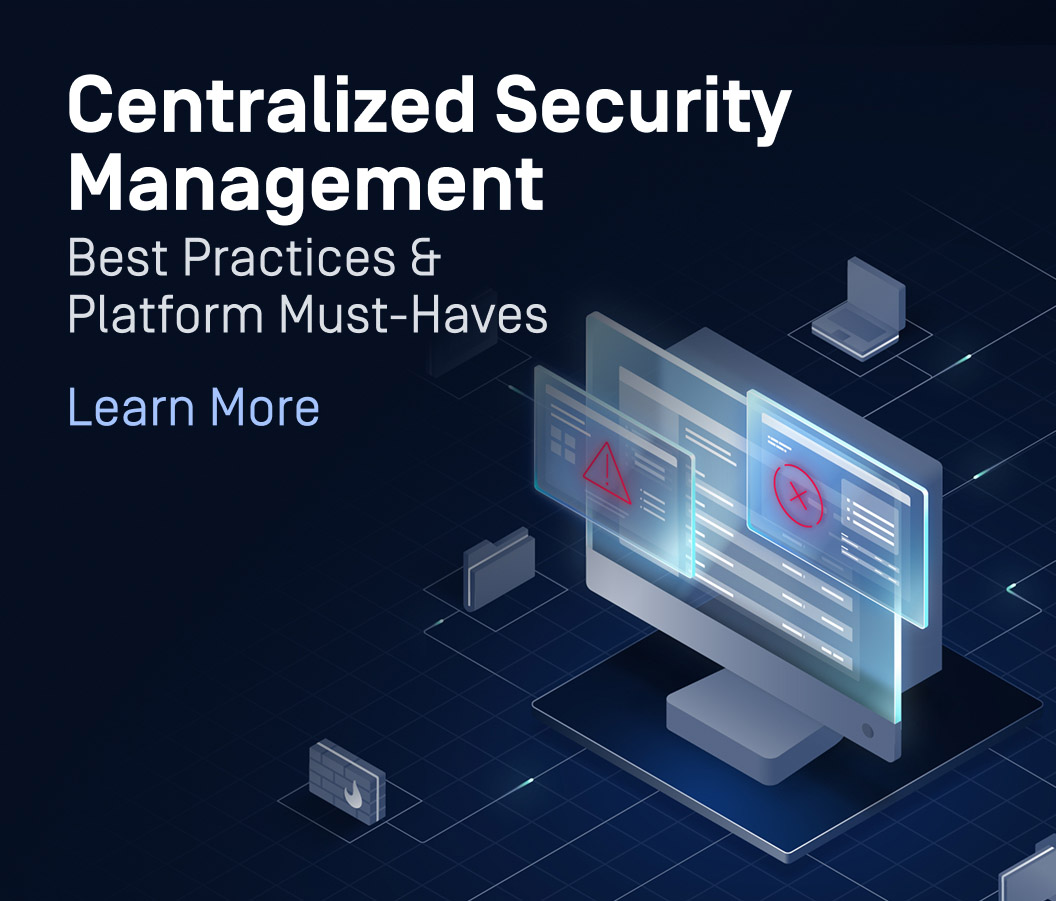Industries today face unprecedented challenges that demand real-time insights, efficient operations, and robust cybersecurity. IT/OT convergence, the integration of IT (Information Technology) and OT (Operational Technology), provides a framework to address these needs by uniting digital systems with physical processes. This transformative approach is reshaping sectors like manufacturing, energy, and healthcare, driving digital transformation and operational resilience.
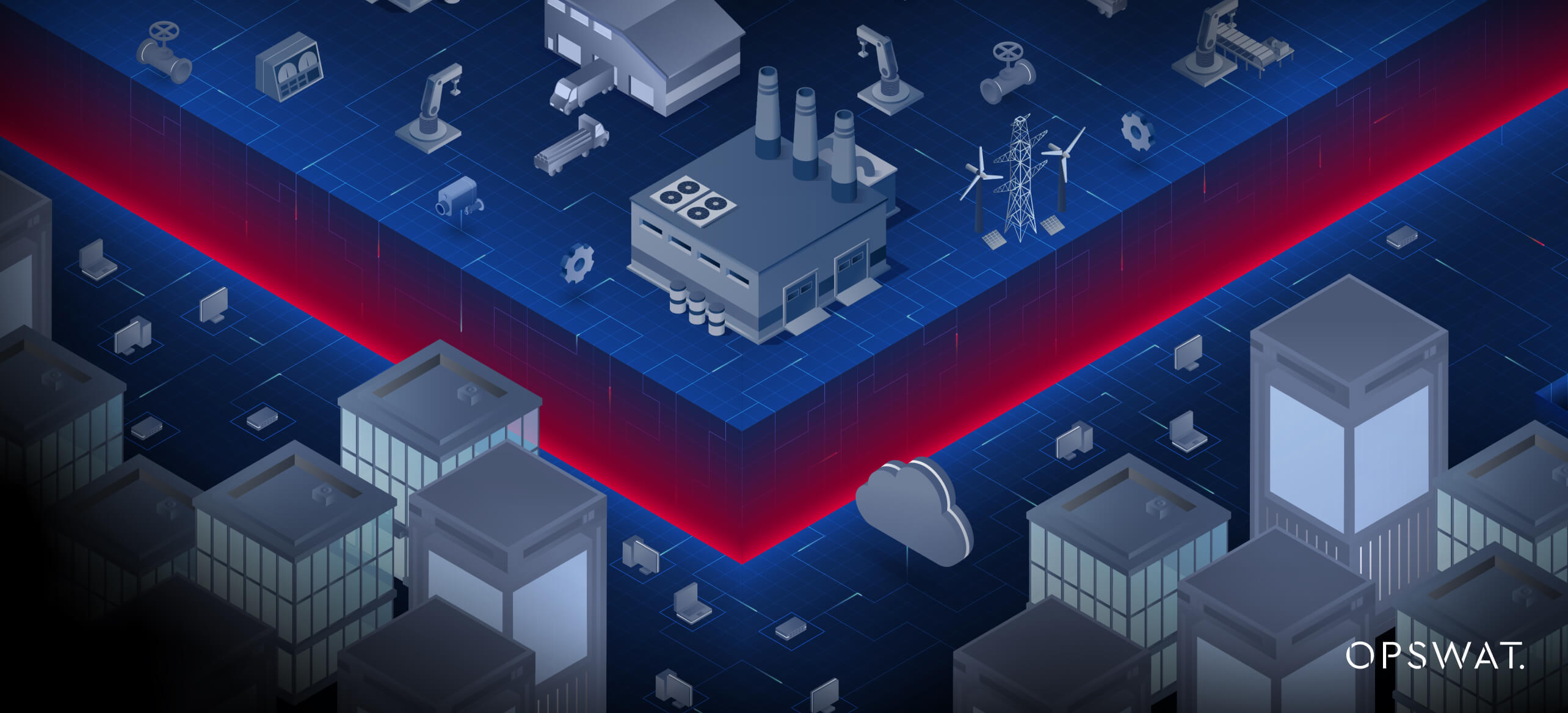
What is the Difference Between IT and OT?
Understanding IT/OT convergence starts with recognizing the distinct roles IT and OT have traditionally played in organizations. IT focuses on managing digital information, while OT centers on monitoring and controlling physical processes. Despite these differences, their integration is increasingly essential for industries to remain competitive and secure.
IT Overview
Information Technology encompasses systems that manage an organization’s data flow and storage. These include software applications, enterprise resource planning (ERP) systems, and cloud infrastructures that enable seamless communication and decision-making. IT is primarily concerned with ensuring data accessibility, accuracy, and security.
OT Overview
Operational Technology includes the systems that control and monitor physical operations, such as industrial machinery and infrastructure. OT ensures efficiency in processes like assembly line manufacturing or utility management, relying on hardware and software such as SCADA systems to operate seamlessly. Its focus is on real-time responsiveness and reliability.
Key Distinctions
While IT is about data-driven decision-making and cybersecurity, OT prioritizes operational continuity and physical system optimization. IT protects digital networks, whereas OT ensures minimal downtime and real-time control of industrial processes.
Why is IT/OT Convergence So Important Now?
IT/OT convergence has become increasingly critical as industries undergo digital transformation and face growing cybersecurity threats. The rise of connected devices, real-time data requirements, and the need for operational efficiency drive this shift.
Additionally, the increased frequency and sophistication of cyberattacks targeting critical infrastructure highlights the urgent need to integrate IT and OT systems to enhance resilience and security.
How Does IT/OT Convergence Work?
The integration of IT and OT involves more than just connecting systems; it’s about creating an infrastructure where data and processes work seamlessly together. This convergence bridges the digital and physical worlds, transforming how industries operate. By uniting IT data expertise with OT operational control, organizations achieve smarter, more efficient systems.
- Integration Process: IT/OT convergence harmonizes different technologies, such as SCADA systems and cloud analytics platforms, into a unified structure. This integration often requires retrofitting older systems with new communication standards and tools, such as IoT devices.
- Communication Protocols: Protocols like MQTT and OPC UA are essential for facilitating communication between IT and OT systems. These protocols ensure consistent data exchange, enabling seamless machine-to-machine communication.
- Real-Time Data Flow: Converged systems enable the flow of OT-generated data into IT systems, allowing real-time analytics to optimize operations. For instance, predictive maintenance systems can identify potential machine failures before they occur, minimizing costly downtime.
- Examples of Platforms: Edge computing platforms, cloud-hosted solutions, and IoT devices are critical tools that enable IT/OT convergence. These technologies enhance the efficiency and scalability of industrial processes.
Benefits of IT/OT Convergence
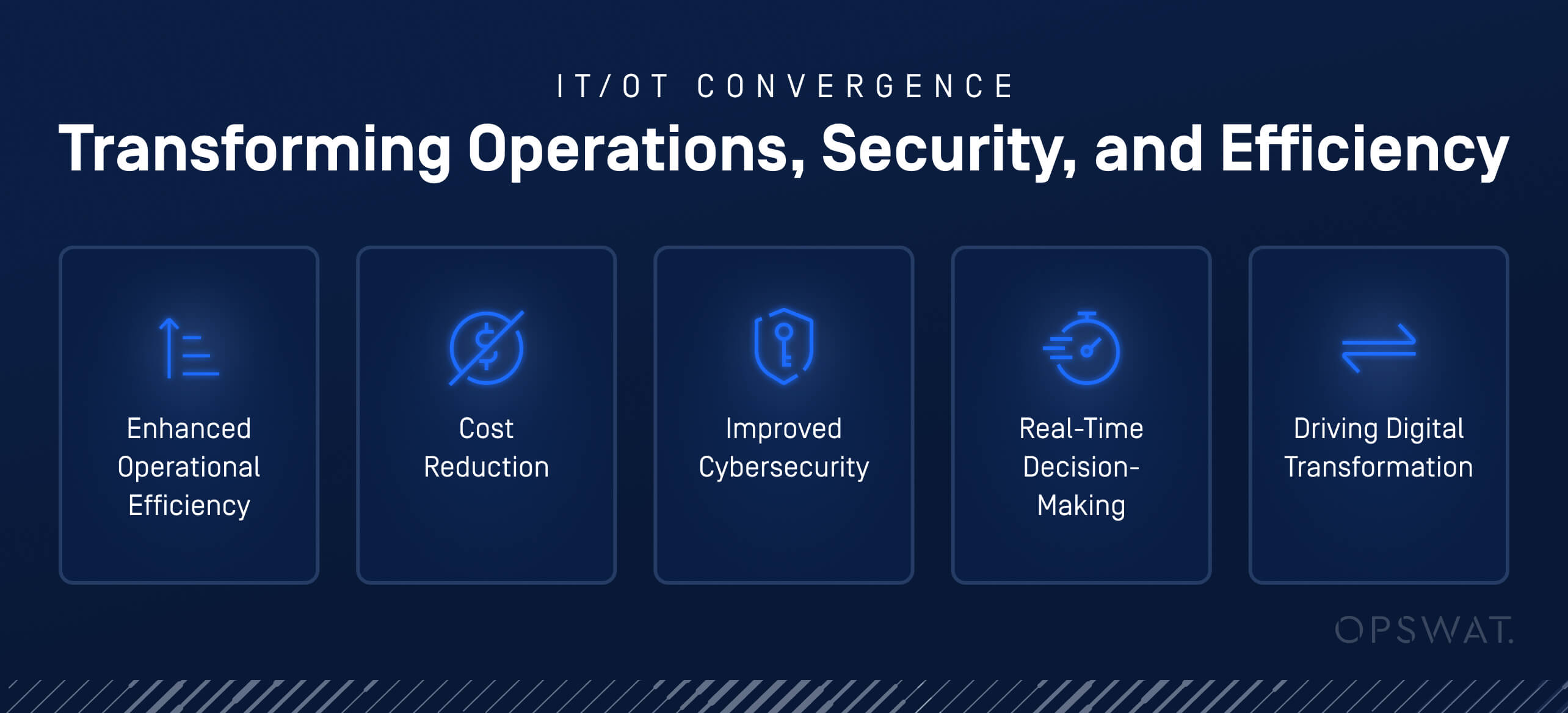
IT/OT convergence offers a wide range of benefits, transforming operations and security across industries. From improving efficiency to driving digital transformation, the advantages are compelling. Below, we’ll explore the most significant benefits and their impact on modern organizations.
- Enhanced Operational Efficiency: Merging IT and OT streamlines processes, improves resource allocation, and reduces inefficiencies. Real-time data insights allow companies to implement predictive maintenance, minimizing unexpected failures and maximizing productivity.
- Cost Reduction: By integrating systems and minimizing redundancies, organizations can lower operational costs. Automation of manual tasks further contributes to cost savings, ensuring more efficient use of resources.
- Improved Cybersecurity: Convergence allows OT systems to benefit from IT’s advanced cybersecurity measures. This reduces vulnerabilities in interconnected networks, protecting against threats like ransomware and phishing attacks. A striking statistic reveals that 75% of cyber threats in critical infrastructure organizations originate from email, underscoring the importance of robust IT-OT security integration (Source: Osterman Report).
- Real-Time Decision-Making: Organizations leveraging IT/OT convergence gain the ability to make faster, more informed decisions. Real-time analytics provide actionable insights, helping industries optimize performance and address challenges proactively.
- Driving Digital Transformation: IT/OT convergence plays a key role in enabling smart factories, connected grids, and other innovations. These advancements mark the evolution of industries toward smarter, data-driven operations.
4 Key Challenges of IT/OT Convergence
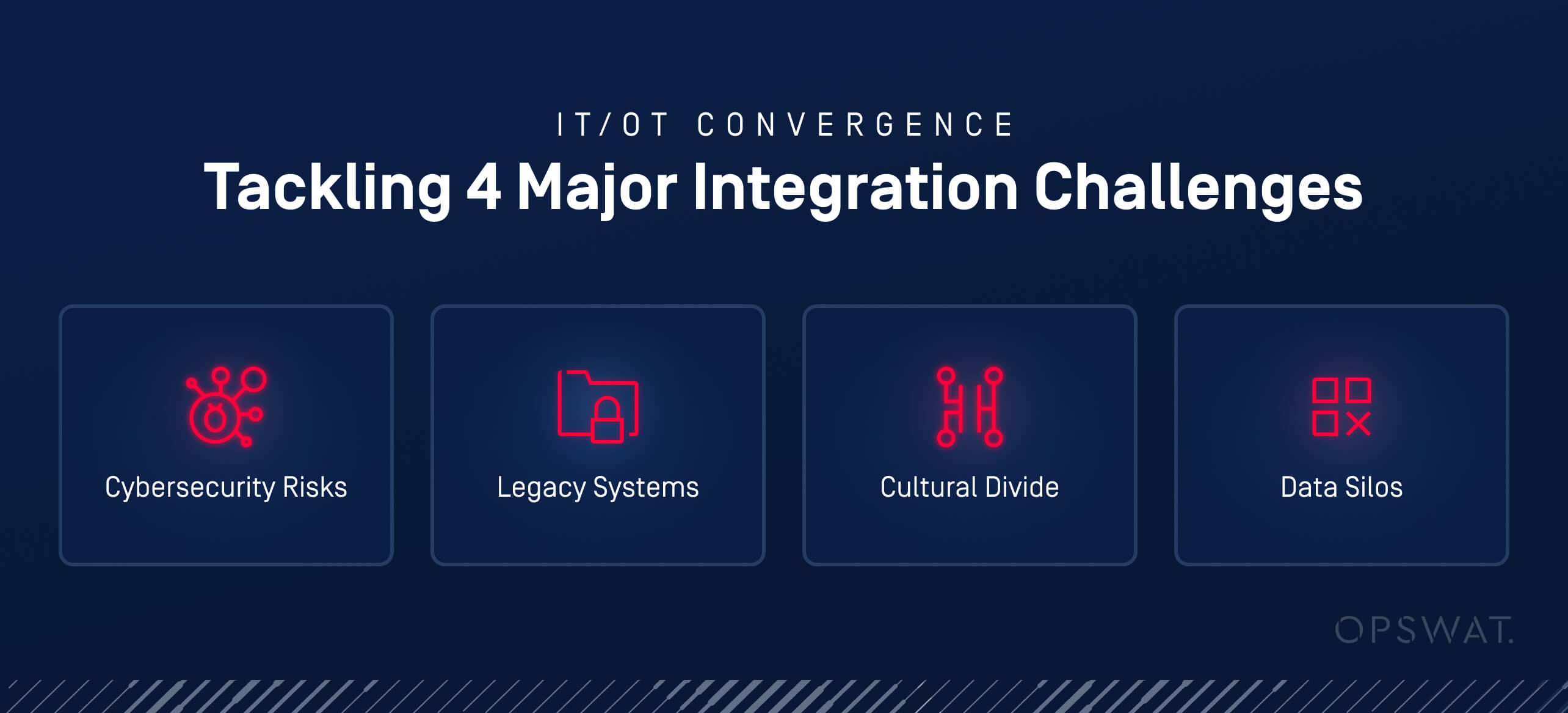
While the benefits of IT/OT convergence are transformative, the path to integration is not without obstacles. Organizations face challenges related to technology, culture, and security that can hinder progress. Overcoming these barriers is critical to unlocking the full potential of IT/OT integration.
- Cybersecurity Risks: Integrating IT and OT systems increases the attack surface, exposing OT environments to cyber threats like ransomware. Successful attacks on IT systems can easily spread to OT networks, disrupting operations and causing significant harm. In fact, between 65% and 80% of critical infrastructure organizations have experienced email-related security breaches in the past 12 months (Source: Osterman Report).
- Legacy Systems: Many industries rely on outdated OT systems that are difficult to integrate with modern IT technologies. Upgrading or replacing these systems can be costly and time-intensive, delaying the adoption of IT/OT convergence.
- Cultural Divide: IT and OT teams often have different priorities, workflows, and expertise. Bridging this cultural gap requires strong collaboration and unified goals across departments.
- Data Silos: Fragmented data systems hinder seamless data sharing between IT and OT, limiting the effectiveness of real-time analytics. Addressing this issue is essential for achieving full integration.
Compliance Implications
IT/OT convergence has significant implications for regulatory compliance, especially as industries become more interconnected. Meeting compliance requirements ensures organizations can operate securely while avoiding penalties. Below, we explore the key regulatory challenges and best practices.
- Regulatory Requirements: Organizations face increasing pressure to comply with regulations that address both IT and OT environments, ensuring the security of interconnected systems. Frameworks like the National Institute of Standards and Technology (NIST) Cybersecurity Framework and the ISO/IEC 62443 standards provide comprehensive guidelines for safeguarding industrial control systems and critical infrastructure.
These frameworks emphasize risk assessment, access control, and incident response to protect converged environments effectively. Compliance requirements are also influenced by regional regulations such as the General Data Protection Regulation (GDPR) in Europe and NERC-CIP standards in North America, which ensure the reliability and security of critical infrastructure. Industry associations like the SANS Institute and CISA also play a vital role in guiding organizations through best practices for IT/OT convergence compliance. - Best Practices: To achieve compliance, organizations should adopt a proactive approach to security and auditing. Implementing a Zero Trust architecture is essential to reduce vulnerabilities, ensuring that both IT and OT environments are monitored and segmented. Organizations should also establish continuous training programs to educate staff on compliance requirements and cybersecurity threats, bridging the cultural divide between IT and OT teams.
Leveraging tools like automated compliance management platforms can simplify adherence to complex regulatory frameworks, saving time and reducing the risk of penalties. Additionally, regular updates to policies and technologies are vital to address emerging threats and maintain compliance over time.
IT/OT Convergence Use Cases
IT/OT convergence is revolutionizing operations across multiple sectors, from manufacturing to healthcare. By integrating systems, organizations gain efficiencies, improve security, and enhance decision-making. Below are examples of how convergence is being applied in key industries.
Critical Infrastructure
Real-time monitoring enabled by IT/OT convergence enhances the resilience of utilities, transportation systems, and water management. This ensures operational continuity and safeguards public safety.
Manufacturing
Convergence optimizes supply chains, improves quality control, and supports predictive maintenance. For instance, IoT-enabled machinery can provide data that prevents equipment failures, reducing downtime. According to the recent SANS 2024 State of ICS/OT Cybersecurity report, machine-to-machine communication improvements are a crucial driver for Industry 4.0 success, facilitated by convergence.
Energy and Utilities
Smart grids powered by IT/OT integration enable efficient energy distribution and real-time demand management. This reduces energy waste and supports renewable energy adoption.
Healthcare
Integrated medical devices and systems improve patient outcomes by enabling real-time data analysis and diagnostics. Convergence also enhances operational efficiency, reducing costs and improving care quality. Furthermore, the SANS report highlights how IT/OT integration in healthcare has significantly reduced system downtime during critical operations.
Impact of Emerging Technologies
Emerging technologies are driving IT/OT convergence forward, enabling smarter, more efficient systems. These advancements provide new capabilities that enhance the integration of digital and physical operations. Below, we highlight six of the most impactful technologies shaping IT/OT convergence.
IoT and IIoT
The Industrial Internet of Things (IIoT) connects physical devices to IT systems, enabling real-time data sharing and process optimization. This connectivity facilitates predictive maintenance and operational efficiency.
AI and Machine Learning
Artificial intelligence (AI) enhances anomaly detection and predictive analytics, enabling smarter decision-making. Machine learning algorithms analyze vast amounts of OT data to identify patterns and optimize performance.
Edge Computing
Processing data closer to its source reduces latency and ensures faster response times. Edge computing is particularly valuable in time-sensitive applications, such as autonomous vehicles.
5G Connectivity
With its low latency and high bandwidth, 5G networks facilitate seamless communication between IT and OT systems. This technology is crucial for industries that rely on real-time data processing.
Blockchain Technology
Blockchain secures data exchanges between IT and OT systems, providing an immutable record of transactions. This enhances trust and ensures data integrity, especially in compliance-sensitive industries.
The Future of IT/OT Convergence
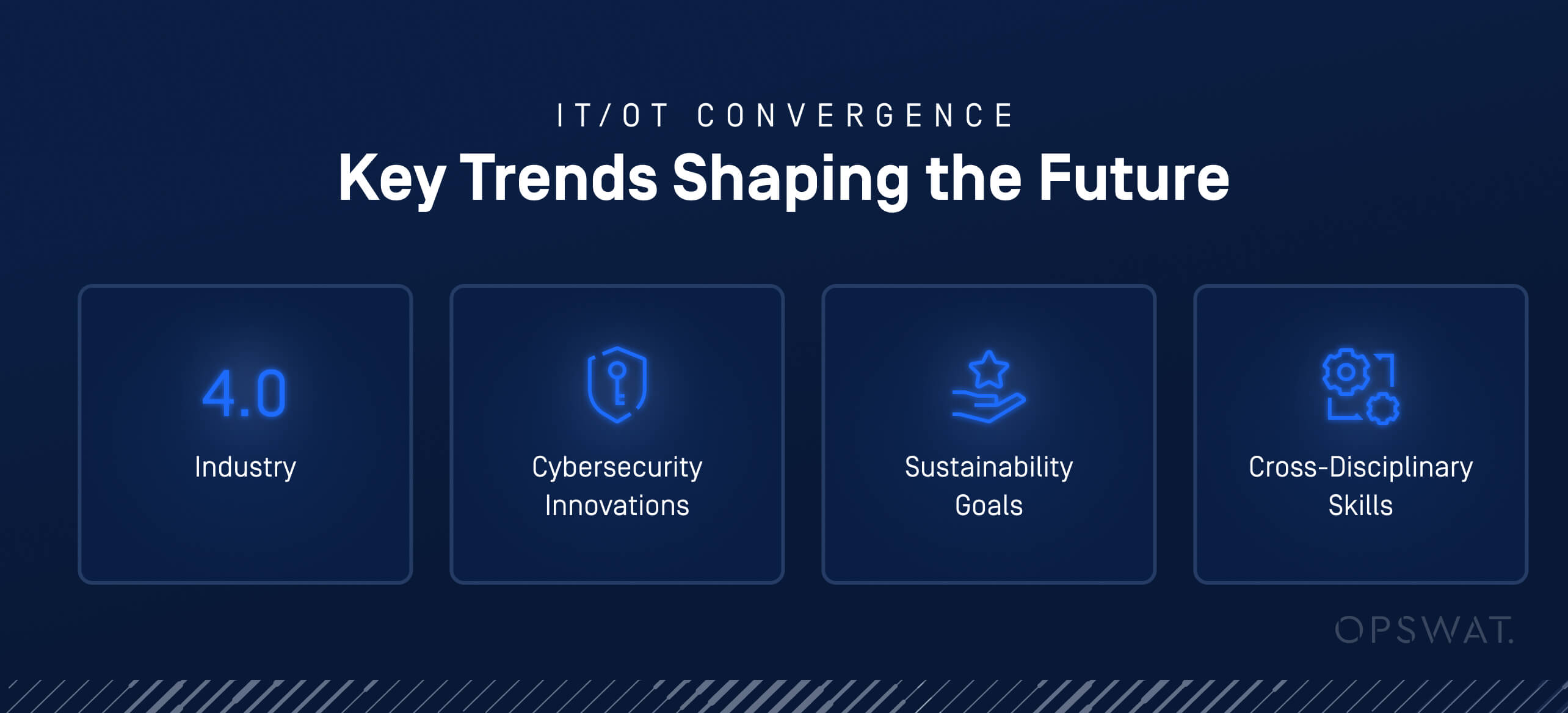
IT/OT convergence is set to play a pivotal role in shaping the future of industries worldwide. As digital transformation accelerates, the importance of integrating IT and OT will only grow. Let’s explore key trends and advancements that will define the future of convergence.
- Industry 4.0: The integration of IT and OT is a cornerstone of Industry 4.0, driving innovations like smart factories, autonomous vehicles, and interconnected infrastructure. These systems represent a new era of intelligent, data-driven operations.
- Cybersecurity Innovations: Advancements in cybersecurity, such as AI-driven threat detection, will address the unique risks posed by IT/OT integration. These innovations will strengthen the security of interconnected systems, reducing vulnerabilities.
- Sustainability Goals: IT/OT convergence supports sustainability by optimizing resource use and minimizing waste. Real-time data insights enable industries to reduce energy consumption and environmental impact.
- Cross-Disciplinary Skills: The demand for professionals skilled in both IT and OT will rise. Organizations will need experts capable of managing converged systems to remain competitive in an increasingly digital landscape.
Unlocking the Future Through Convergence
IT/OT convergence is transforming how industries operate, combining digital and physical systems for greater efficiency and security. While challenges like cybersecurity risks and legacy systems remain, the benefits of IT/OT integration far outweigh the obstacles. By embracing this convergence, organizations can unlock the full potential of digital transformation, ensuring a competitive edge in an interconnected world.
For more information on how OPSWAT's MetaDefender platform addresses IT/OT convergence challenges with robust security solutions, contact us today.
